Updated with additional information August 25, 2020
Pesto is amazingly versatile. Traditionally, pesto is strictly basil, garlic, olive oil, pine nuts and parmesan.
This post contains affiliate links. If you click through a link I may get a small commision at no expense to you. Read my disclosure policy here.
When I first started experimenting with different pesto recipes, I thought I was being very adventurous using lemon basil and almonds! But last week I made pesto out of radish leaves and sunflower seeds which was absolutely delicious.
We tend to think of pesto as a topping for pasta. However, my daughter and I have been discovering how good it is on sandwiches, potatoes, burgers, bagels, eggs and more. I’ve seen recipes for pesto on chicken, pizza, hummus, guacamole, grilled meat, fish, tacos, quinoa, and roasted or sauteed veggies.
Pesto can be frozen to save all that summer goodness for the cold of winter. For freezing, I recommend blending all the ingredients except the cheese. You can freeze in small containers or zip lock bags. I freeze pesto in ice trays before storeing in a bag or jar. That way, I have serving size portions I can take out 1 or 2 at a time.
The Ingredients
Let’s break down the pesto recipe and the many variations you can try to experience the infinite possibilities of pesto! Pesto ingredients fall into 5 categories: Greens and Herbs, Garlic, Nuts, Oil and Liquids, and Cheese.
Greens and Herbs
Always use the freshest greens and herbs available. Dried herbs can be added for seasoning, but won’t create a fresh green pesto.
- Basil
- Parsley
- Marjoram
- Spinach
- Kale
- Radish Leaf
- Carrot tops
- Collard Greens
- Nasturtium Leaves and Flowers
- Arugula
- Watercress
- Cilantro
- Oregano
- Sage
- Thyme
- Mint
Garlic
I’ve seen a recipe for pesto that didn’t include garlic, but I think it’s an absolute necessity. Raw garlic is incredibly good for you too–its antiviral, antibacterial and antimicrobial. You can also use roasted garlic for a flavor change-up.
Nuts
You can use nuts as is, or toast them in a dry skillet or in the oven to bring out their flavors.
- Pine Nuts
- Cashews
- Pistachios
- Sunflower Seeds
- Almonds
- Walnuts
- Pumpkin Seeds (Pepitas)
- Hemp Seeds
- Pecans
- Peanuts
Oil and Liquids
- Olive Oil, good quality Extra Virgin, preferred!
- Vinegar – cider, red wine, balsalmic
- Lemon or Lime Juice
- Avocado and water can be used as an alternative to oil!
Cheese
- Parmesan
- Romano
- Asiago
- Feta
- Goat Cheese
- Nutritional Yeast adds a cheesy flavor for vegans.
Additional Flavor Options
- Sun Dried Tomatoes
- Capers
- Anchovies or Sardines
- Roasted Beets
- Roasted Red Peppers
Infinite Possibilities of Pesto Formula
My goal has been to create a formula for pesto that will allow unlimited substitutions of whatever ingredients you prefer! And since I’m not about to run out to the store for a single ingredient, I love the versatility of this approach.
No pine nuts? Try peanuts.
Not enough basil? Add some parsley.
Plus this allows me to use whatever I have most of in the garden and preserve the summer flavors!
Be sure to compost any greens you don’t use; learn how to compost here.
Also, read more about my gardens and pursuing a zero waste lifestyle.
- 1-1/2 to 3 c. greens, lightly packed
- 1/2 cup nuts
- 4-8 T. olive oil
- 2-3 cloves garlic
- 1/2 c. cheese
- Salt and pepper to taste
Cilantro Carrot Top Pesto
My daughter loves cilantro, so we decided to harvest enough for pesto. I was concerned about it being way too strong for me and since I had just harvested a few carrots I decided to try using the tops.
First we rinsed and patted dry the greens. We used 3/4 cups each cilantro and carrot tops.
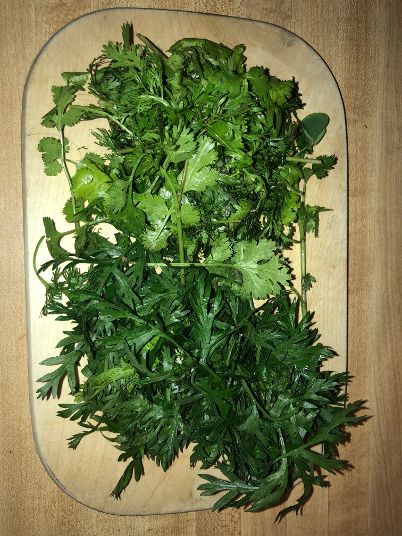
Cilantro and Carrot Tops, rinsed and patted dry. 
Garlic Cloves 
Salted nuts may mean you should use less salt.
You can make pesto with a blender, food processor, stick blender or the old fashioned method of using a mortar and pestle if you have the patience!
Peel garlic and add to blender. Add nuts. Mix briefly and scrape down the sides. Repeat until well chopped and mixed. You may need to experiement with the settings on your blender for the best results.
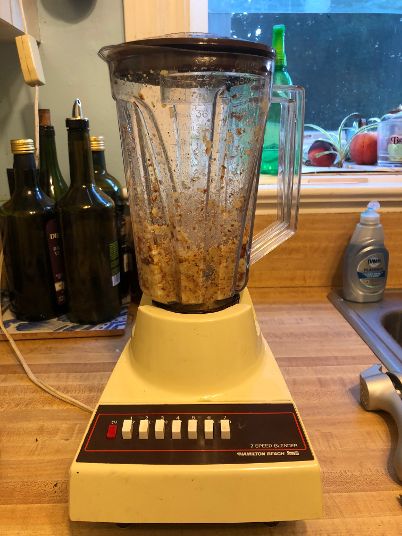
Chop garlic and nuts in the blender, turning blender off to scrape and mix 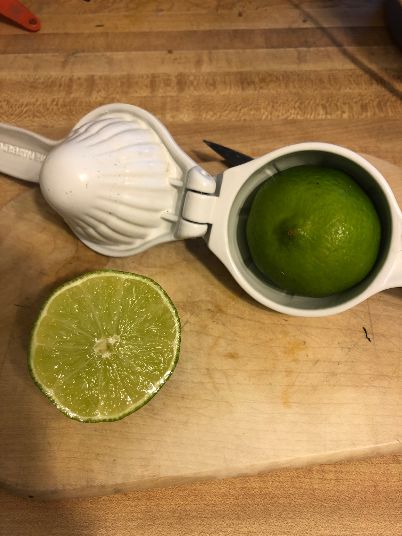
I used the juice of half a lime. 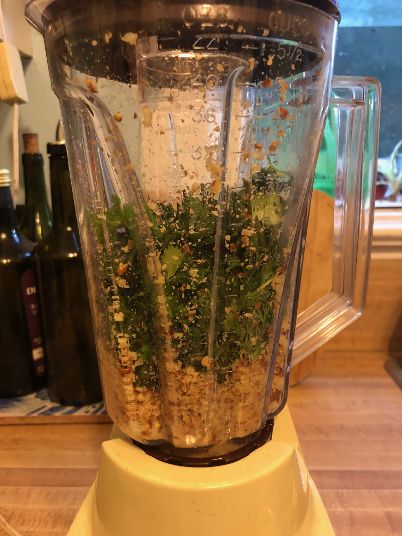
Add greens!
Add greens and lime juice and continue blending, mixing and scraping. You’ll probably need to dig out the most blended portion from the bottom several times.
Next, add the oil all at once while blender is off or drizzle it in slowly through the small opening while the blender is running.
Freeze!
If you are going to freeze your pesto, stop here! Whether you freeze it in one container or make individual serving sizes in ice cube trays, be sure to label your pesto and include instructions for adding the cheese!
Otherwise, add the cheese now. We used goat cheese for this recipe because we love it, but also because cow’s milk cheeses tend to bother my daughter’s stomach.
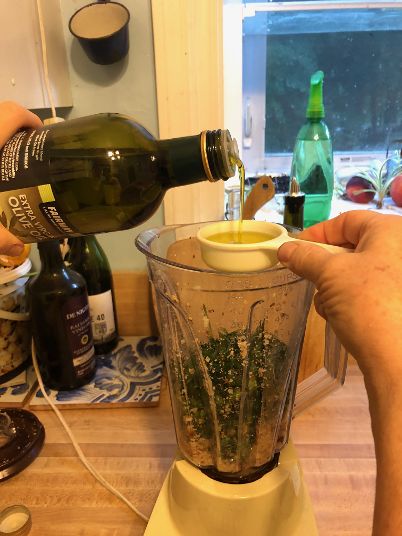
Add the oil. 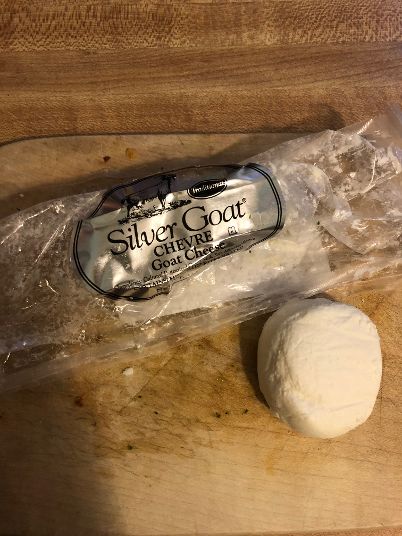
Goat cheese is not traditionally used in pesto, but I saw it in a few recipes. 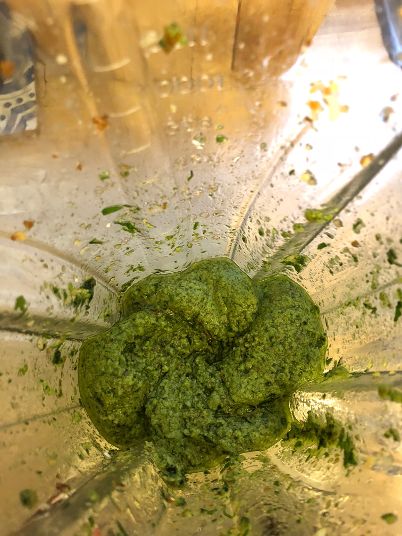
The pesto looks ready! I don’t mind it a bit chunky!
Be sure to taste your pesto before adding salt and pepper so you don’t overseason. I was surprised that we definitely needed salt, despite using salted almonds.
Finally, store your pesto in the refrigerator with extra oil on top to prevent browning.
My personal review
So, was the cilantro too strong? Well, yes, a bit for my taste. I ended up adding parmesan and a bit more oil as well as salt and fresh ground pepper. This made a huge difference and elevated the mix of flavors while mellowing the cilantro.
I was disappointed that I couldn’t taste the carrot tops. I often use them in salads and they have a mild carrot flavor. I’ll definitely try them again for pesto, either on their own or with another mild tasting green.
Because this pesto has such a strong flavor, I find I prefer it as a condiment on sandwiches, eggs and potatoes rather than as the main attraction on pasta. But cilantro lovers will be in heaven!
This recipe has been updated to include changes I made or would make–because there are infinite possibilities of pesto!
UPDATES!
Last week I made a new batch of pesto. I used the food processor rather than a blender, and let me tell you, it was so much easier! I may turn into a food processor fanatic!
The latest version I made was pretty classic, but amazingly good! Here’s how I made it:
- 2 cups Genovese Basil
- 1/2 cup almonds
- 4 T Rosemary Olive Oil (Recipe here!)
- 1/2 cup paremesan shreds
- 2 cloves garlic
- Salt and Pepper to taste
Mix all in food processor, scraping down the sides as needed. Just by adding the Rosemary Olive Oil the flavor just popped and I loved it!
The Cilantro Pesto Recipe
Cilantro Pesto

Cilantro Pesto is for cilantro-lovers! The bold taste pairs well with eggs, burgers and of course, pasta.
Ingredients
- 1/2 c. Cilantro
- 1 c. Carrot Tops or substitute Basil, Spinach or Parsley
- 6 T. Extra Virgin Olive Oil
- 1/2 c. Almonds or Pepitas
- 1/2 c. Parmesan
- 2-3 cloves garlic
- Juice of 1/2 lime or 2 T.
- Salt and fresh-ground pepper to taste
Instructions
- Rinse greens and pat to dry.
- Peel garlic and put in blender with nuts. You can use a stick blender or food processor if you prefer.
- Pulse garlic and nuts, frequently stirring and scraping down the sides until ingredients are paste-like.
- Add cilantro and other greens as well as the lime juice.
- Add oil gradually and continue blending and stirring until mixed and smooth.
- Add parmesan cheese and salt and pepper to taste. Mix thoroughly until smooth.
- Store up to a week in refrigerator with extra oil on top to prevent browning.
Notes
If you'd like to freeze your pesto and enjoy the fresh taste of the garden in winter, leave the cheese out of the pesto. Freeze in an ice cube tray for easy to use, serving-size pieces. Label with directions to add the cheese before using.
Nutrition Information:
Yield:
8Serving Size:
1Amount Per Serving: Calories: 190Total Fat: 16gSaturated Fat: 3gTrans Fat: 0gUnsaturated Fat: 13gCholesterol: 5mgSodium: 245mgCarbohydrates: 9gFiber: 2gSugar: 5gProtein: 4g
Estimated nutrition information may not be fully accurate.
Please share what ingredients you have tried in pesto in the comments!

Pingback: Herb Infused Oils and Vinegars | My Frugal Nature